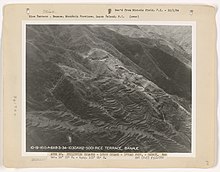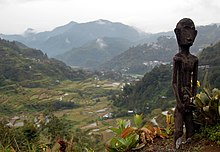Banaue Rice Terraces
| Banaue Rice Terraces | |
|---|---|
 The Banaue Rice Terraces of Ifugao | |
Location in Luzon | |
| Location | Ifugao, Philippines |
| Coordinates | 16°54′N 121°3′E / 16.900°N 121.050°E |
The Banaue Rice Terraces (Filipino: Hagdan-hagdang Palayan ng Banawe) [bɐˈnawe] are terraces that were carved into the mountains of Banaue, Ifugao, in the Philippines, by the ancestors of the Igorot people. The terraces are occasionally called the "Eighth Wonder of the World".[1][2][3] It is commonly thought that the terraces were built with minimal equipment, largely by hand.[4] The terraces are located approximately 1,500 meters (4,900 feet) above sea level. These are fed by an ancient irrigation system from the rainforests above the terraces. It is said that if the steps were put end to end, it would encircle half of the globe.[5]
Locals up to this day still plant rice and vegetables on the terraces, although more and more younger Ifugaos do not find farming appealing,[6] often opting for the more lucrative hospitality industry generated by the terraces.[7] The result is the gradual erosion of the characteristic "steps", which require constant reconstruction and care. In 2010, a further problem encountered was drought, with the terraces drying up completely in March of that year.[8]
Anthropologist Otley Beyer has estimated that the terraces are over 2000 years old, but several researchers dispute this and contend that they were built much later.[9][10] Nevertheless, rice is an ancient ancestral crop of the Philippines, having been carried by Austronesian migrations into the islands since at least 1500 BCE (3500 years ago).[11]
Current threats to the terraces include the giant earthworms ("olang" in Ifugao) of the genus Pheretima or Polypheretima elongata which are blamed for causing damage to the terraces,[12] as well as rodents of the genus Chrotomys and snails.[13]
Cultural significance
Ifugao rice culture


The terraces are found in the province of Ifugao and the Ifugao people have been its caretakers. Ifugao culture revolves around rice, the Black Rice kalinayan, and the culture engenders an elaborate array of celebrations linked with agricultural rites from rice cultivation to rice consumption. The harvest season generally calls for thanksgiving feasts, while the concluding harvest with rites called tango or tungul (a day of rest) which entail a strict taboo on any agricultural work. Bayah (rice wine), rice cakes, and betel nut are also consumed as part of the festivities.[14]
The Ifugao people practice traditional farming spending most of their labour at their terraces and forest lands while occasionally tending to root crop cultivation. The Ifugaos have also been known to culture edible shells, fruit trees, and other vegetables which have been exhibited among Ifugaos for generations. The difficulty of planting kalinayan and other rice varieties with the soil type in these areas leads to the building of the rice terraces entailing construction of retaining walls with stones and rammed earth which are designed to draw water from a main irrigation canal above the terrace clusters. Indigenous rice terracing technologies have been identified with the Ifugao’s rice terraces such as their knowledge of water irrigation, stonework, earthwork and terrace maintenance. As their source of life and art, the rice terraces have sustained and shaped the lives of the community members.
Organic farming
In March 2009 the Ifugao rice terraces were declared[15] free from genetically modified organisms (GMO). An event declaring this achievement was organized in Dianara Viewpoint in collaboration with local and municipal government, Greenpeace, and the Miss Earth Foundation.
Official heritage designation
The Banaue Rice Terraces refer to the cluster close to the Banaue poblacion as seen from the viewpoint. Contrary to popular belief perpetrated by its inclusion on the twenty peso banknote, the Banaue Rice Terraces are not a UNESCO World Heritage Site. They were not included in the UNESCO inscription Rice Terraces of the Philippine Cordilleras due to the presence of numerous modern structures, making it score low in the integrity criterion of UNESCO.[16]
The five clusters inscribed as part of the Rice Terraces of the Philippine Cordilleras are Batad, Bangaan, Hungduan, Mayoyao Central and Nagacadan.[17] Batad and Bangaan are under the jurisdiction of the Municipality of Banaue but are not called the Banaue Rice Terraces.
The Banaue Rice Terraces were declared by the Philippine government as a National Cultural Treasure under Ifugao Rice Terraces through Presidential Decree No. 260 signed by President Ferdinand Marcos in 1973.[18]
Tourism

Another thriving economy in the Banaue Rice Terraces is tourism.[19] The Tourism industry has developed a number of activities for visitors which may include traditional sightseeing of the terraces and visits to the tribes at the foot of the terraces. A Mumbaki[20] (traditional Ifugao witch doctor) is also recommended[21] to visitors: these doctors can perform spiritual healing rituals.[22] Domestic tourism however has gone down over the past few years.[23][when?]
The park is featured on the reverse side of the New Design series one thousand peso note that was circulated from 1991 to 2018 as well as the reverse side of the New Generation Currency twenty peso note being in circulation since 2010.
Other notable rice terraces in Ifugao
Aside from the Banaue Rice terraces there are 4 other similar terraces:[24][25] the Batad Rice Terraces, Mayoyao Rice Terraces, Hapao Rice Terraces, and Kiangan Rice Terraces. Soil types in this mountainous province are similar to that used to fabricate clay pots or clay jars (also used in construction by firing clay). The Batad Rice Terraces are located in Barangay Batad in Banaue, these terraces resemble an amphitheatre. The Mayoyao Rice Terraces are for a rice variety called "tinawon",[26] a rare type of organic rice which is grown in red and white varieties in these terraces. The Hapao Rice Terraces are located in Hungduan and are stone-walled from Sagada rock formation and date back to 650 AD.[27] The Kiangan Rice Terraces are in Banaue, on which are grown the rice varieties of nagacadan and julungan.
See also
References
- ^ Filipinasoul.com.‘The Best’ of the Philippines - its natural wonders Archived November 5, 2014, at the Wayback Machine
- ^ National Statistical Coordinating Body of the Philippines. FACTS & FIGURES:Ifugao province
- ^ About Banaue > Tourist Attractions Archived December 14, 2008, at the Wayback Machine
- ^ Talavera, Catherine (June 29, 2018). "Banaue Rice Terraces rehab to start by year end". Philippine Star. Retrieved February 16, 2019.
The Banaue Rice Terraces, built by the Ifugaos by hand some 2,000 years ago, is among the country's national cultural treasures and is listed as a UNESCO (United Nations Educational, Scientific, and Cultural Organization) World Heritage Site.
- ^ Department of Tourism: Ifugao Province Archived March 2, 2009, at the Wayback Machine. Accessed September 4, 2008.
- ^ Jesus, Totel V. De (April 7, 2018). "Not just Boracay: Banaue Rice Terraces also need help". ABS-CBN News. Retrieved February 16, 2019.
Add to that, the loss of interest among the younger generations to farming. They'd rather go down to the cities and try their luck for a more stable income in call centers, real estate and other salary-based careers.
- ^ "Banaue Rice Terraces Pictures, Photos & Facts - Ifugao". famouswonders.com. March 15, 2009. Retrieved March 30, 2017.
- ^ Agence France-Presse [1] Drought ravages famed Banaue rice terraces. March 9, 2010.
- ^ Cabreza, Vincent (July 15, 2013). "For Ifugao rice terraces, age should not matter". Inquirer.net. Retrieved January 29, 2018.
- ^ "Ifugao Rice Terraces may be younger than we think". Rappler. April 29, 2015. Retrieved January 29, 2018.
- ^ Bellwood, Peter; Hiscock, Peter (2005). "Australia and the Austronesians". In Scarre, Christopher (ed.). The Human Past: World Prehistory and the Development of Human Societies. Thames & Hudson. pp. 264–305. ISBN 9780500294208.
- ^ "Giant worms destroying ancient rice terraces". The Telegraph. March 3, 2006. Retrieved September 21, 2018.
- ^ "The brittle Steps to the Sky – T". www.insights-philippines.de. Retrieved November 10, 2018.
- ^ World Heritage Sites and Schlessinger Media and ISBN 9781417103423
- ^ "Ifugao rice terraces are GMO-free--officials". Philippine Daily Inquirer. Retrieved July 17, 2009.
- ^ "Banaue Rice Terrace". Archived from the original on April 13, 2014. Retrieved September 4, 2014.
- ^ "UNESCO World Heritage Centre". UNESCO. Retrieved January 1, 2011.
- ^ "Presidential Decree No. 260 August 1, 1973". The Lawphil Project - Arellano Law Foundation. Retrieved September 5, 2014.
- ^ "Eighth Wonder of the World". Visit Banaue. Archived from the original on June 2, 2009. Retrieved July 17, 2009.
- ^ "The Mumbaki". Philippine Daily Inquirer. Archived from the original on May 29, 2009. Retrieved July 17, 2009.
- ^ "Tribal rituals cleanse, unite towns". Philippine Daily Inquirer. Retrieved July 17, 2009.
- ^ "Banaue Rice Terraces, the Eighth Ancient World Wonder?". Tourism on the Edge. August 28, 2012. Retrieved March 30, 2017.
- ^ "Down on Domestic Tourism". Philippine Daily Inquirer. Retrieved July 17, 2009.
- ^ "Banaue Rice Terraces". PhilSite. Retrieved July 17, 2009.
- ^ "Ifugao Is Famous For..." Wow Philippines. Archived from the original on March 2, 2009. Retrieved July 17, 2009.
- ^ "Ifugao exports 2.5 tons of 'Tinawon' rice". PIA.gov. Retrieved July 17, 2009.
- ^ "Rice Terraces-Banaue". Luz alma. Retrieved July 17, 2009.



